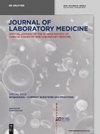运动医学中的无细胞DNA对临床实验医学的启示
IF 1.8
4区 医学
Q4 MEDICAL LABORATORY TECHNOLOGY
引用次数: 2
摘要
摘要背景物理活动会对几种有前景的候选生物标志物的浓度产生强烈影响,包括无细胞DNA(cfDNA)。内容这篇叙述性综述描述了目前对物理应变如何导致cfDNA增加的理解,并讨论了这如何干扰临床实验室医学中标准化cfDNA分析的尝试。概述一般来说,人体的所有细胞都可以释放DNA,而中性粒细胞被描述为在静息条件下释放cfDNA的主要来源。在低物理负荷下,cfDNA被免疫细胞迅速释放。最近,我们发现中性粒细胞是导致急性运动中cfDNA增加的主要细胞类型。耐力和力量训练都会影响液体活检(LB)分析的信噪比,影响几分钟到几天的临床有效性。此外,我们还讨论了为什么在癌症围手术期的各种身体痛苦可以改善或损害信噪比。因此,包括但不限于血细胞活化在内的生理事件可能会引发LB环境中cfDNA超灵敏检测的预分析挑战。展望我们讨论了为什么未来标准化液体活检的尝试可能会从对cfDNA生理释放机制的更深入理解中受益。本文章由计算机程序翻译,如有差异,请以英文原文为准。
Cell-free DNA in sports medicine: implications for clinical laboratory medicine
Abstract Background Physical activity can have a strong impact on the concentration of several promising candidate biomarkers, including cell-free DNA (cfDNA). Content This narrative review describes the current understanding of how physical strain leads to increases of cfDNA and discusses how this interferes with attempts to standardize cfDNA analysis in clinical laboratory medicine. Summary In general, all cells of the human body can release DNA, whereas neutrophils are described as the major source releasing cfDNA under resting conditions. Event at low physical load, cfDNA is rapidly released by immune cells. We recently, identified neutrophils as the major cell-type contributing to cfDNA increases during acute exercise. Both, endurance and strength training can affect the signal-to-noise ratio of liquid biopsy (LB) analysis, affecting the clinical validity between minutes up to several days. Furthermore, we discuss why physical distress of various kinds in a perioperative cancer setting can improve or compromise signal-to-noise. Therefore, physiological events including, but not limited to, activation of blood cells can provoke pre-analytical challenges for ultra-sensitive detection of cfDNA in LB settings. Outlook We discuss why future attempts to standardize liquid biopsy may therefore profit from a deeper understanding of the physiological release mechanisms of cfDNA.
求助全文
通过发布文献求助,成功后即可免费获取论文全文。
去求助
来源期刊

Journal of Laboratory Medicine
Mathematics-Discrete Mathematics and Combinatorics
CiteScore
2.50
自引率
0.00%
发文量
39
审稿时长
10 weeks
期刊介绍:
The Journal of Laboratory Medicine (JLM) is a bi-monthly published journal that reports on the latest developments in laboratory medicine. Particular focus is placed on the diagnostic aspects of the clinical laboratory, although technical, regulatory, and educational topics are equally covered. The Journal specializes in the publication of high-standard, competent and timely review articles on clinical, methodological and pathogenic aspects of modern laboratory diagnostics. These reviews are critically reviewed by expert reviewers and JLM’s Associate Editors who are specialists in the various subdisciplines of laboratory medicine. In addition, JLM publishes original research articles, case reports, point/counterpoint articles and letters to the editor, all of which are peer reviewed by at least two experts in the field.
 求助内容:
求助内容: 应助结果提醒方式:
应助结果提醒方式:


